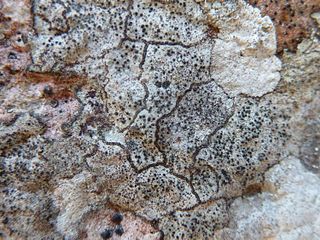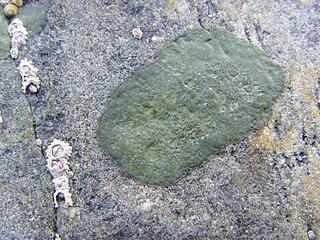Clavascidium is a genus of lichens in the family Verrucariaceae. The genus was circumscribed in 1996 by Austrian lichenologist Othmar Breuss. Because the type species of the genus, Clavascidium umbrinum, has been shown using molecular phylogenetics to belong to genus Placidium, Cécile Gueidan and colleagues proposed to unite Clavascidium with Placidium in a 2009 publication. Despite this, the genus has been retained in recent publications of fungal classification.

Hydropunctaria is a genus of saxicolous (rock-dwelling), crustose lichens in the family Verrucariaceae. The genus includes both aquatic and amphibious species, with members that colonise either marine or freshwater habitats. The type species, Hydropunctaria maura, was formerly classified in the large genus Verrucaria. It is a widely distributed species common to littoral zones. Including the type species, five Hydropunctaria lichens are considered marine species: H. adriatica, H. amphibia, H. aractina, H. orae, and H. oceanica.

Parabagliettoa is a genus of crustose lichens in the family Verrucariaceae. It has 3 species. The genus was circumscribed in 2009 by Cécile Gueidan and Claude Roux, with Parabagliettoa dufourii assigned as the type species.
Atla oulankaensis is a rare species of saxicolous (rock-dwelling) lichen in the family Verrucariaceae. It has been recorded in Finland and in the Canadian arctic, growing on calciferous rock and on high-pH soil.
Atla tibelliorum is a rare species of saxicolous (rock-dwelling) in the family Verrucariaceae. Found in Finland and the United States, it was formally described as a new species in 2016 by Juha Pykälä and Leena Myllys. The type specimen was collected by the first author near Toskaljärvi lake ; there, in a calcareous alpine grassland at an altitude of 730 m (2,400 ft), the lichen was found growing on dolomite pebbles. It has also been collected from Franklin Bluffs, Alaska, where it was growing on high-pH soil in dwarf shrub tundra. The species epithet tibelliorum honours "Sanja and Leif Tibell, the mother and father of the genus Atla".
Atla vitikainenii is a species of saxicolous (rock-dwelling) in the family Verrucariaceae. Found in northern Finland, it was formally described as a new species in 2016 by Juha Pykälä and Leena Myllys. The type specimen was collected by the first author from Oulanka National Park, at an altitude of 185 m (607 ft); there, it was found growing on pebbles in a northeast-facing dolomite rock outcrop. The species epithet honours Finnish lichenologist Orvo Vitikainen, who, according to the authors, "has contributed in many ways to our knowledge of the taxonomy, ecology and biogeography of Finnish lichens".

Wahlenbergiella is a genus of saxicolous (rock-dwelling), crustose lichens in the family Verrucariaceae. It has three species, all of which live in marine intertidal zones where they get periodically immersed in seawater. Wahlenbergiella closely resembles another lichen genus that includes marine species, Hydropunctaria. Wahlenbergiella was circumscribed in 2009 by Cécile Gueidan and Holger Thüs. They initially included two species: W. striatula, and the type,W. mucosa. The generic name honours Swedish naturalist Göran Wahlenberg, who originally described both of these species.
Sporodictyon is a genus of crustose lichens in the family Verrucariaceae. It has 10 species. Most species grow on rocks, although some have been recorded overgrowing soil and mosses.
Verrucaria oulankaensis is a rare species of saxicolous (rock-dwelling) crustose lichen in the family Verrucariaceae. It is found in north-eastern Finland, where it occurs on calcareous rocks on river shores.
Verrucaria ahtii is a species of saxicolous (rock-dwelling) crustose lichen in the family Verrucariaceae. It is found in Finland, Lithuania, Russia, and Switzerland, where it occurs on calcareous pebbles.
Atla alaskana is a species of saxicolous (rock-dwelling), crustose lichen in the family Verrucariaceae. Found in Alaska, it was formally described as a new species in 2015 by Sanja and Leif Tibell. The type specimen was collected from Sukakpak Mountain at an altitude of 776 m (2,546 ft); there, it was found growing on calciferous rock ledges in open dwarf shrub. The lichen has a thick, whitish-grey thallus with a granular to verrucose (warted) texture.
Atla recondita is a rare alpine species of saxicolous (rock-dwelling), crustose lichen in the family Verrucariaceae. Found in Sweden, it was formally described as new to science in 2015 by Sanja and Leif Tibell. The type specimen was collected from Hamrafjället at an altitude of 1,075 m (3,527 ft); there, it was found growing on calciferous rocks. It is known only from a few locations in this area, collected at an altitude range between 610 and 1,075 m. The lichen has a thin olive brown-coloured thallus and ascospores with 9–15 transverse septa and 3–4 longitudinal septa. The authors note that it is not possible to distinguish this species from the similar Polyblastia by morphology alone.

Atla alpina is a species of saxicolous (rock-dwelling), crustose lichen in the family Verrucariaceae, and the type species of the genus Atla. Found in Europe, it was formally described as a new species in 2008 by Sanja Savić and Leif Tibell. The type specimen was collected near Djupdalsvallen at an altitude of 1,170 m (3,840 ft), where it was found growing on northwest-facing, vertical slate rocks. In addition to Sweden, the lichen has been recorded from Scandinavia, Spitsbergen, Novaya Zemlya, Austria, and Germany, at altitudes ranging from 345 to 2,700 m.
Atla palicei is a species of saxicolous (rock-dwelling), crustose lichen in the family Verrucariaceae. Found in Sweden, it was formally described as a new species in 2008 by Sanja Savić and Leif Tibell. The type specimen was collected in the Kärkevagge valley, where it was found near a stream growing on a west-facing calcareous boulder. It is only known to occur in the Torne Lappmark in Sweden at elevations between 410 and 650 m, but the authors suggest that it is "probably overlooked elsewhere". The lichen has a blackish-brown, scurfy thallus that is diffusely areolate, and ascospores measuring 43–51 by 23–26 μm.
Atla praetermissa is a species of saxicolous (rock-dwelling), crustose lichen in the family Verrucariaceae. Found in Scandinavia, it was formally described as a new species in 2008 by Sanja Savić and Leif Tibell. The type specimen was collected in Andersjöåforsen. In addition to Sweden, it has also been recorded in Norway; it grows on calcareous rocks near streams, at altitudes ranging from 165 to 955 m. The lichen has a superficial, thin and sometimes mesh-like, crustose thallus that is grey to dark green, sometimes with a brownish tinge. Its ascospores are narrowly ellipsoidal and measure 44.7–49.2 by 19.0–22.4 μm. Atla praetermissa has an unidentified green alga as a photobiont.
Hydropunctaria rheitrophila is a species of freshwater, saxicolous (rock-dwelling), crustose lichen in the family Verrucariaceae. It was formally described as a new species in 1922 by German lichenologist Georg Hermann Zschacke as a species of Verrucaria. Christine Keller, Cécile Gueidan, and Holger Thüs transferred it to the newly circumscribed genus Hydropunctaria in 2009. It is one of several aquatic lichens that are in this genus. The photobiont partner of Hydropunctaria rheitrophila is a yellow-green alga.
Trimmatothele is a genus of saxicolous (rock-dwelling), crustose lichens in the family Verrucariaceae. It has five species. The genus was formally published by lichenologist Alexander Zahlbruckner in 1903. The type species, Trimmatothele perquisita, was originally collected from Norway by Johannes M. Norman, who placed it in the genus Coniothele in 1868. Diagnostic characteristics of Trimmatothele include a thin thallus with a smooth surface; small perithecia that are partially immersed in the substrata and have an involucrellum; asci that contain multiple ascospores; and small, simple ascospores. Trimmatothele has been described as one of the most poorly known genera of lichens due to the rarity of its species, the few available herbarium specimens, and some missing type specimens.

Wahlenbergiella mucosa is a species of saxicolous (rock-dwelling), crustose lichen in the family Verrucariaceae. It is a marine species that grows in the littoral zone, and therefore remains immersed in seawater for extended periods. Its photobiont partner is the green alga Paulbroadya petersii.
Atla wheldonii is a species of terricolous (ground-dwelling), crustose lichen in the family Verrucariaceae. Found in Europe, it was formally described as a new species in 1947 by William Gladstone Travis from specimens collected from sand dunes in Lancashire, England, in 1924. Sanja Savić and Leif Tibell transferred the taxon to genus Atla in 2008 following molecular phylogenetic analysis that showed that it, along with three other Northern European species, comprised a distinct clade in the Verrucariacae.




